
BUILDING ON TWO DECADES OF TRUST AND SUPPORT
Alwar Ramanujam N,
Deputy General Manager (MECH), TI IC
For two decades, Alwar Ramanujam has been quietly constructing his career with L&T and along the way been associated with several iconic projects where he has left his mark. Starting with the Vizag Vessel Project, followed by the 3rd Narmada Bridge, the 3rd Mandovi Bridge in Goa, the Durgam Cheruvu Bridge in Hyderabad, and the 2nd Ishwar Gupta Bridge Project, he has been building trust and expertise, well supported by his seniors and team members. Today, he finds himself at the Dhubri-Phulbari Bridge project, steeling himself to overcome the challenges thrown up both by an extremely demanding project and the mighty River Brahmaputra, that has a mind of its own.

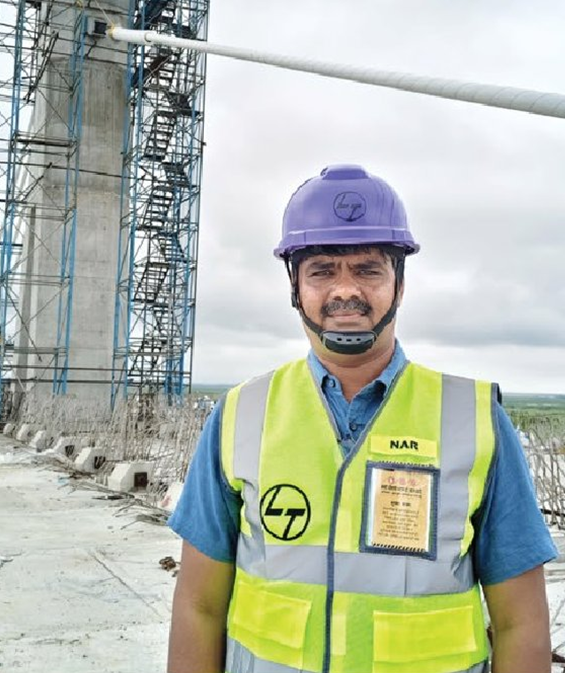
“I am leading the segmental erection works on the Dhubri side,” informs Alwar, “and compared to my previous bridge projects, this one seems far more challenging. Apart from the unpredictability of the Brahmaputra that changes its course every monsoon, the remoteness of the site makes it very difficult to mobilize and retain skilled workers,” he rues. “Sourcing and planning are very tricky, but despite all these roadblocks, we are still on course to delivering this project on time,” he says with determination.
His confidence stems from the able support he has been receiving at site to complete all his critical tasks. “They listen to me very patiently about all my bottlenecks and help me to overcome them one by one,” he says thankfully. “My team members understand the management requirements very well and are all very cooperative & committed to achieve our targets. Their dedication and timely support are well appreciated.”
Technology, Alwar is positive, can change their lives and improve efficiency. “In a bridge project, manually threading strands inside ducts is extremely tedious, and if this can be done by a new automation technology, it will both improve productivity and save time.” He also advocates the introduction of Modular Robotic Segment for handling and lifting.
On his personal side, a native of Alwarthirunagiri, in Tamil Nadu’s Tuticorin district, Alwar is married to A. Kanna Priya, a homemaker, and fondly recalls celebrating his 18th wedding anniversary on August 30 as a cherished milestone. He cherishes his sons, A.K. Nithin Athithya and A.K. Jitendra too, and despite a demanding schedule, he finds solace in music and family chats.
In conclusion, he shares, “L&T accepts mistakes and allows us to learn from our mistakes, creating a healthy and growth-oriented culture.”
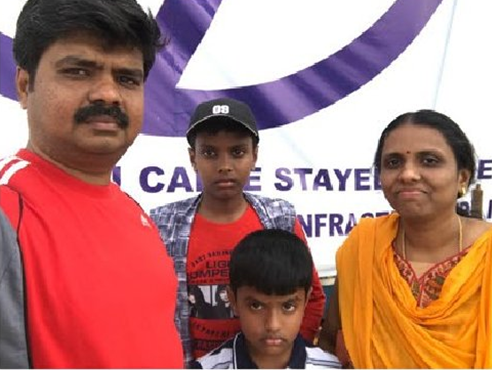
ENJOYING A SENSE OF PURPOSE, PRIDE, AND PROFESSIONALISM
Manas Ghosh - Senior Construction Manager (Civil), TI IC
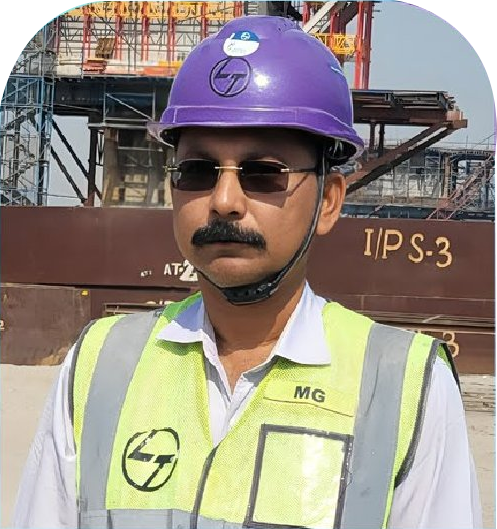

Since joining L&T in January 2021, Manas Ghosh has had the opportunity to be associated with two iconic projects. “My first project was the MAHSR C6 Package where I was Section In-charge for a 16 km stretch, responsible for piling works, and successfully executed around 1,680 piles,” he shares triumphantly. Thereafter, at the Dhubri-Phulbari bridge project, his present assignment, Manas served as the Section In-charge for marine well and caisson foundation works across both the North and South Channels from August 2022 to December 2024. “In January 2025, I was given the additional responsibility by our PD to lead the main bridge segment erection as a Section In-charge that reflects not only my growth but L&T’s trust in empowering individuals,” he says, almost respectfully. “With a sense of purpose, pride and professionalism, I remain focused on ensuring timely, safe, and high-quality execution of the segment erection work.”
While his seniors have empowered him with strategic direction and valuable support, his team members drive on-ground execution with discipline and enthusiasm. “This synergy enables us to consistently deliver with speed and scale,” he states, acknowledging the reasons for his success. In a river bridge project, every activity is interdependent and even a small delay can cascade into major setbacks. “By breaking down the work into daily, even hourly targets and closely tracking progress, we can anticipate risks, effectively mobilize resources, and take corrective actions in real time,” he observes.
When executing the marine caisson foundation works, the extremely low water level was unsuitable for caisson launching and for the Caisson Shifting Barge (CSB) to reach the required lifting point. “This could have seriously delayed the project by several months but with my PD’s guidance and support I proactively implemented a special pushing arrangement using available resources to keep the project on schedule,” Manas shares proudly. Responsible for the marine well foundation works, involving complex operations in a highly unpredictable and hostile river environment, Manas has his task cut out.
One of Manas’s most memorable achievements was the launching of the first 12.0 m dia. caisson. “It was really challenging requiring complex coordination with tight timelines and changing weather conditions, but seeing the first caisson locked in place perfectly aligned, within tolerance after weeks of planning, trial runs, and safety checks was an incredibly proud moment,” he beams. He won appreciation from the senior management for completing the well bottom as well plugging 500 cum of concrete ahead of schedule.
On his personal front, Manas who hails from Kolkata, West Bengal, is married to Soma, a homemaker, and their son, Akash, is the apple of their eyes. Meeting people and forging new friendships are what he likes best.
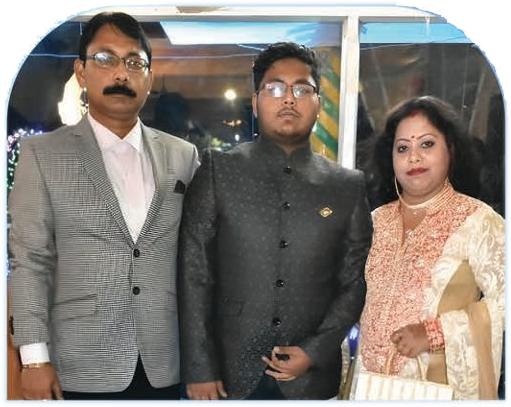
COMMITTED TO DELIVER
Zulfequar Ahamad
Senior Construction Manager — TI IC
His most memorable moment at L&T has been winning a DELTA award and according to Zulfequar Ahamad, what he loves most about L&T is its work culture, transparent management, digital initiatives, and team bonding. Although he is at his first project with the company at the Dhubri-Phulbari Bridge project, he, along with the project team, is committed to deliver a project of rare scale & complexity.
“In the pier table works, we have introduced a jig to fix the diaphragm reinforcement and implemented a one-side prestressing method, after discussing with the design team, both of which have significantly reduced construction time while maintaining our pace of construction,” he shares exuberantly.
Zulfequar has learnt the hard way that several factors contribute to the successful execution of large-scale projects. “Resource utilization, team bonding, collaboration and co-ordination, regular encouragement and distribution of responsibilities are critical to deliver large-scale projects,” he shares, adding that labour retention is equally important.
Challenges have been aplenty at site that Zulfequar and team have been addressing in the best way possible. To combat material theft, they have installed CCTV cameras, anti-theft alarms, secured storage systems, and conduct unannounced drone surveillance, complemented by on-site security personnel, that have both safeguarded resources and kept the project on track.

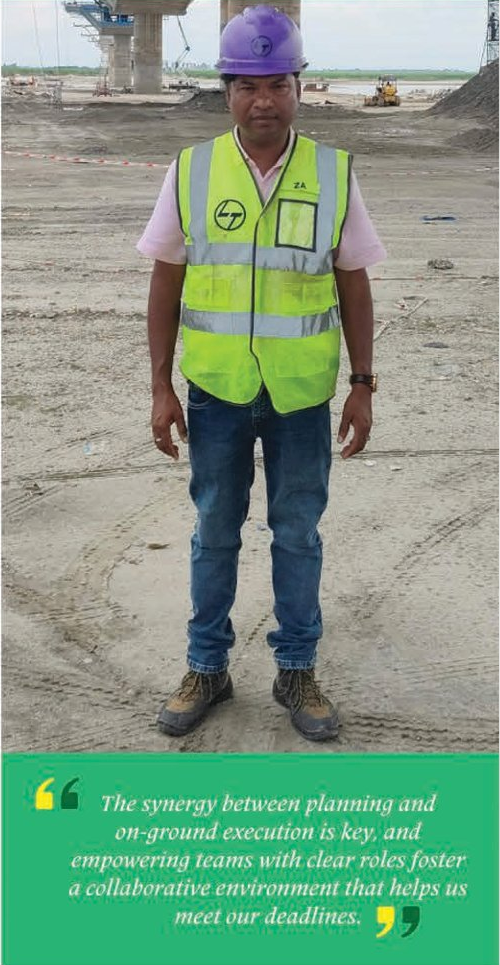
Supported by the team management’s prompt resource approvals and his team’s effective utilization of assets, they have maintained momentum at site. “The synergy between planning and on-ground execution is key,” he asserts, “and empowering teams with clear roles foster a collaborative environment that helps us meet our deadlines.” Looking ahead, he envisions adopting modular shutter and formwork systems to further enhance the efficiency of pier table construction.
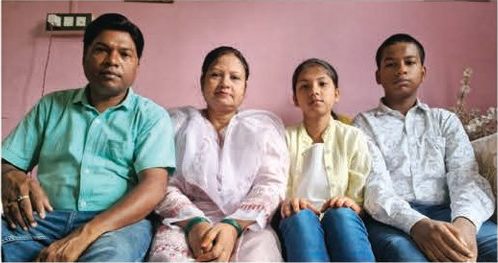
Hailing from Nautanwa, West Champaran, Bihar, Zulfequar is married to Afsana Khatoon, a homemaker, and they are blessed with two children: son, Mohammad Rehan, and daughter, Alia Naz. In his spare time, he enjoys playing volleyball in the evenings and watching movies on weekends.
With a strong commitment to excel, Zulfequar and his team are shaping the Dhubri-Phulbari Bridge Project into a landmark of speed and scale.
PLANNING IS IMPORTANT, BUT COMMUNICATION AND FLEXIBILITY IN EXECUTION EVEN MORE SO
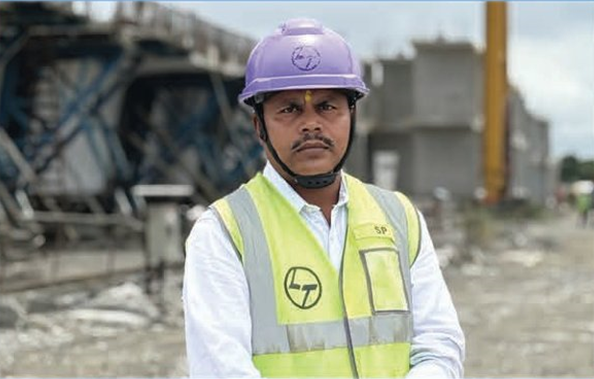
Subhendu Pakhira
Senior Construction Manager, Tl IC
Although just two years old in L&T and at his first project, Subhendu Pakhira has been speedily acquitting himself to the challenges of constructing India’s longest river bridge across the mighty Brahmaputra. “Yes, planning is important,” he nods assertively, “but dynamic communication and flexibility in execution are what keep the project moving on schedule. No matter how efficient the casting yard is, if it is not aligned with real-time site requirements, delays are inevitable. In my experience as a Precast Yard Construction Manager, the crucial factor in delivering large-scale projects with speed is seamless coordination between production, logistics, and site erection teams.”
Realizing that rigid planning could fail under practical field conditions, especially when site priorities change due to unforeseen challenges, the team implemented a rolling production and dispatch schedule with real-time updates from the erection team that allowed them to adjust casting and delivery priorities daily, based on actual progress and needs at the site.
On the tech adoption front, Subhendu mentions a real-time digital tracking system they have implemented to monitor the progress of precast element casting, curing, stockyard inventory, and delivery status that is helping them identify bottlenecks and reduce segment casting cycle time. “With a digital quality management tool, we conduct real-time checks and approvals that has reduced rework by improving accountability, traceability and improved communication between the engineers and QA/QC,” he shares, happy that thanks to this tool the NCRs raised by the client has dropped by an impressive 80%. “It has resulted in quality assurance, client satisfaction and trust,” he smiles.

Challenges are a way of life at site especially at such a challenging one as the Dhubri-Phulbari project. Apart from implementing a flexible casting schedule and holding weekly meetings to proactively adjust priorities, Subhendu mentions the appointment of a logistics coordinator to resolve misalignments between casting schedules, transport availability, and erection needs that were leading to idle time and delays and evolving a multi-skilling strategy to address the issue of lack of skilled labour.
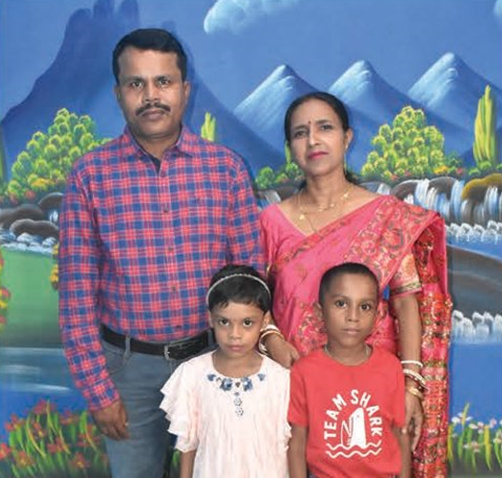
Thriving on the encouragement from his Project Director, V R Saravana Kumar, Planning In-charge, Abhirup Deshmukh, he appreciates the support of his team members: Prasenjit Halder, Amit Kumar Samanta, Subrata Mondal, Abhishek Yadav, Ramesh Azmeera, and Shashinath Pandey.
A native of Medinipur, West Bengal, the most cherihed moment in Subhendu’s life and that of his wife, Nilima, an erstwhile teacher at Kendria Vidyalaya though now a homemaker, was when they were blessed with twins, son, Subhranil and daughter, Nilasha. What keeps Subhendu ticking away from work are volleyball, table tennis, gardening, travelling and, of course, his delightful twins.
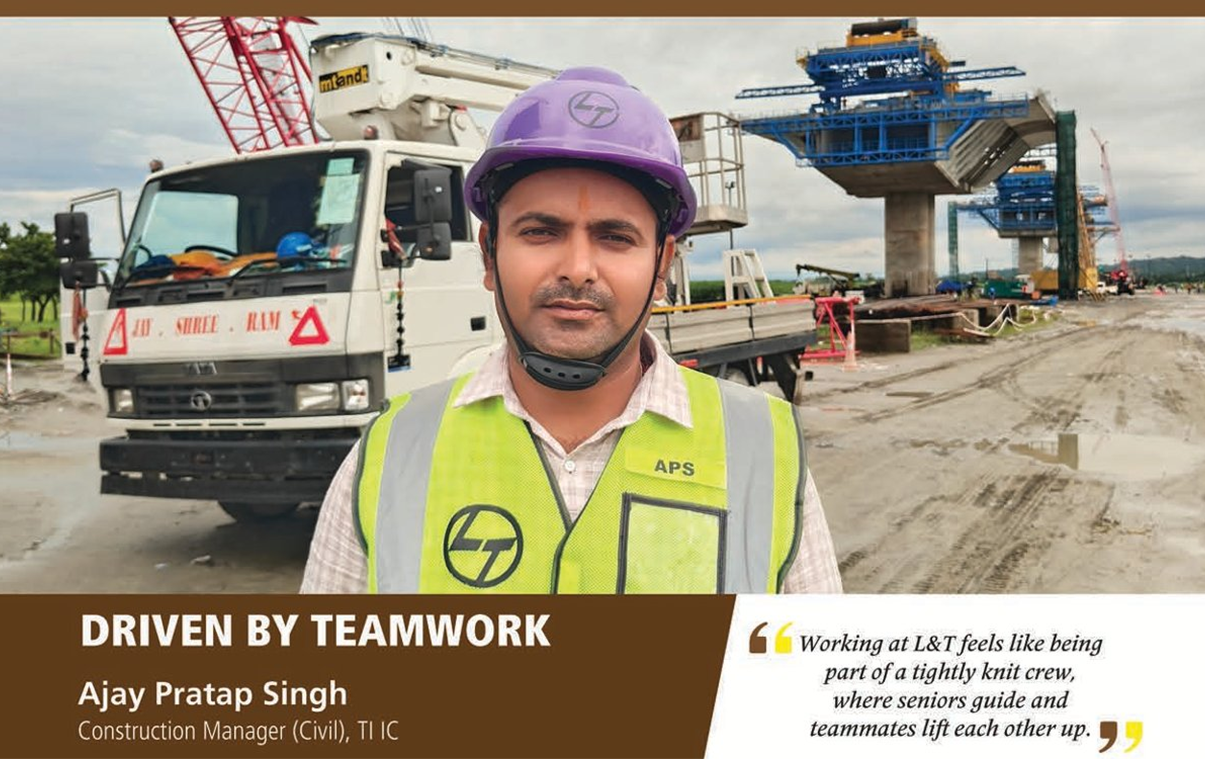
“Working at L&T feels like being part of a tightly knit crew, where seniors guide and teammates lift each other up,” says Ajay Pratap Singh, his smile reflecting the camaraderie that fuels his work. That he is passionate about his work is reflected in what he thinks about the company he works for. “L&T’s strong ethical values, transparency, trust in young talent and empowerment inspire me,” he shares, “as also opportunities for learning and growth and its commitment to building nation transforming infrastructure with uncompromising quality, safety & engineering excellence.”
Hailing from Ballia, Uttar Pradesh, Ajay joined L&T in April 2022 as Section Head Sub-structure Works at the Dhubri-Phulbari Bridge Project, his first venture with the company. Now overseeing both superstructure and substructure works, he is helping to shape this vital infrastructure with precision and speed. “Every foundation we lay connects lives,” he shares with quiet passion.
The team, according to Ajay, utilizes BIM to catch design clashes early, streamlining site operations. “BIM resolves issues before they slow us down,” he notes. Manpower shortages challenged progress, but they partnered with local subcontractors, provided rigorous training, maintained a buffer team, and boosted morale with rewards.
High groundwater levels were managed with a robust dewatering system. “Speed depends on proactive planning and tight coordination,” he adds. “Clear knowledge of expectations and readiness at the front end are everything.” His seniors, led by Project Director VRSK, offer clear goals and swift approvals, creating a high-performance environment. “Their strategic inputs empower us to take bold decisions,” Ajay beams and says that the project team’s ownership and commitment drive seamless collaboration. He envisions an Al-powered real-time monitoring system with CCTV and drones to enhance site efficiency further.
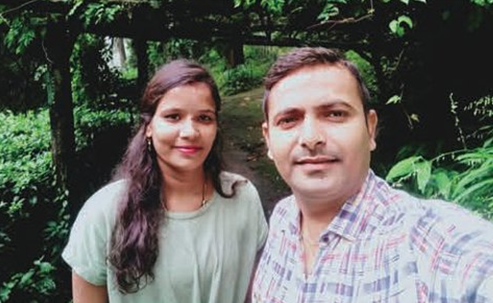
Married to Shalini, a homemaker, Ajay cherishes Sundays spent playing with neighbourhood kids or taking long drives. “Those moments recharge my spirit,” he says warmly.
A career highlight was completing a critical project phase under tight deadlines, a testament to his resilience. With his innovative approach and collaborative heart, Ajay is forging the Dhubri-Phulbari Bridge Project into a symbol of engineering excellence, uniting teams to build a brighter future.
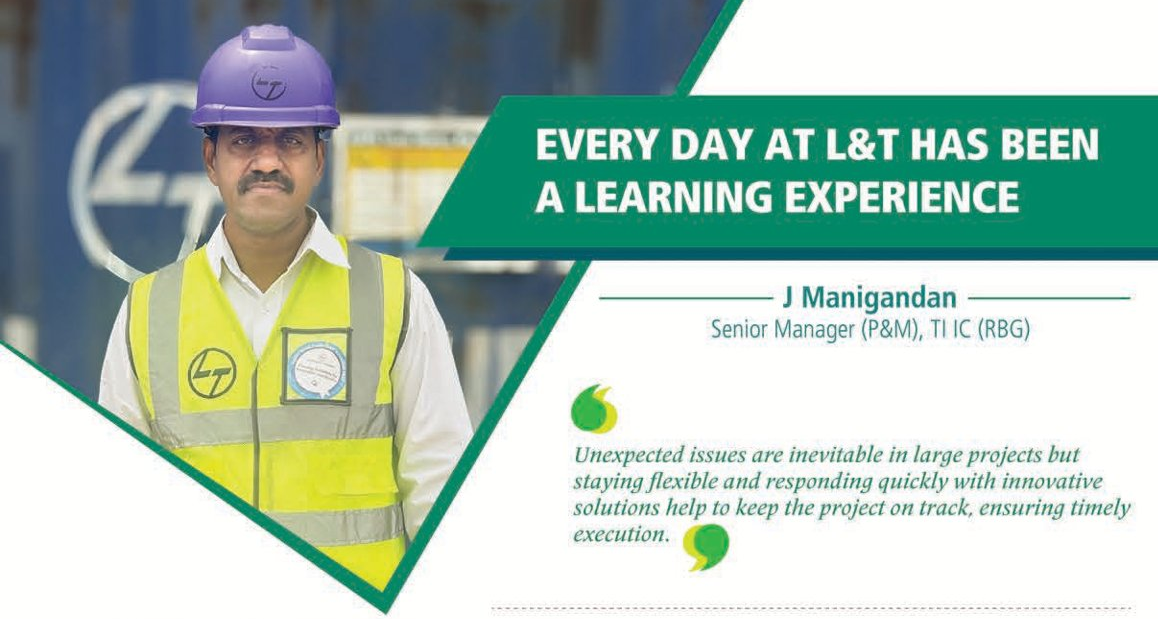
After nearly 20 years and 5 projects with the company, J Manigandan is undoubtedly proud to be a part of the L&T family. “Each day at L&T has been a learning experience, and I truly value the collaborative environment that has empowered me to take on challenges, execute projects efficiently, and continuously improve,” he shares passionately. Not surprisingly, the day he joined L&T has been his life’s most memorable one. “L&T gave me a platform to grow, learn, and continuously improve myself and over time, I gained valuable knowledge, boosted my confidence, and have progressed to my current position,” he says grateful for the opportunity that has transformed his life.
Presently, at the RRTS project, one of Manigandan’s major challenges was to work in the tunnel section. “Having earlier been part of road and ballast-less track projects, I lacked the experience of working inside tunnels, which required a different approach and specialized methodologies,” he remarks, adding that it is a first-of-its-kind project that involve installing slabs inside the tunnel. “We custom-designed and fabricated a Gantry Crane suitable for operations within the confined environment of the tunnel with which we successfully installed slabs for the entire 23-km tunnel section using just four Gantry Cranes,” he shares jubilantly, describing the initiative as a major milestone.
According to Manigandan, delivering large-scale projects with speed depends on effective planning combined with seamless teamwork, communication, proactive problem-solving and adaptability. “A well-structured plan provides clear milestones and resource allocation, while open communication ensures that challenges are identified and addressed promptly,” he notes. “Unexpected issues are inevitable in large projects but staying flexible and responding quickly with innovative solutions help to keep the project on track, ensuring timely execution.” The construction sector encompasses a wide range of complex processes, and he is convinced that the implementation of digital solutions can significantly enhance cost-efficiency, accelerate project execution, and improve quality and safety standards.
Attributing his success to the strong and healthy working relationships he has maintained with both his peers and superiors, he says, “Their constant guidance, support, and willingness to share their expertise have been instrumental in my professional development. At the same time, I will always remain grateful to my parents and family for their constant support and encouragement.”
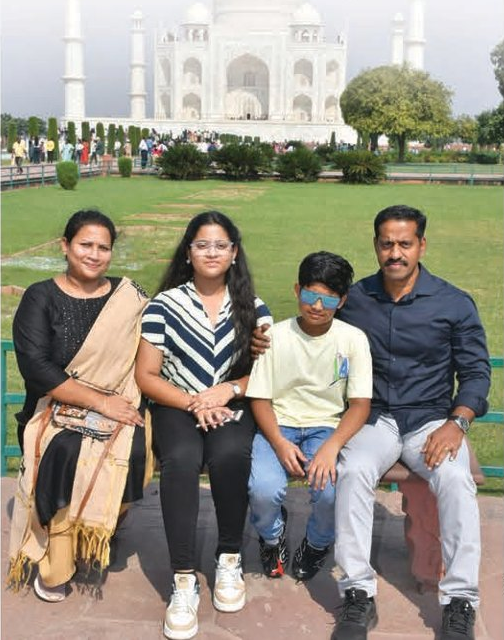
Hailing from Nagapatnam, Tamil Nadu, Manigandan’s life partner is Chintu Parkavi, a teacher, and they are blessed with two children: daughter Joyshna Sejal and son, Harshith Nathan. “Whenever I find the time, I make it a point to go to the gym and maintain a health-conscious lifestyle,” he laughs.
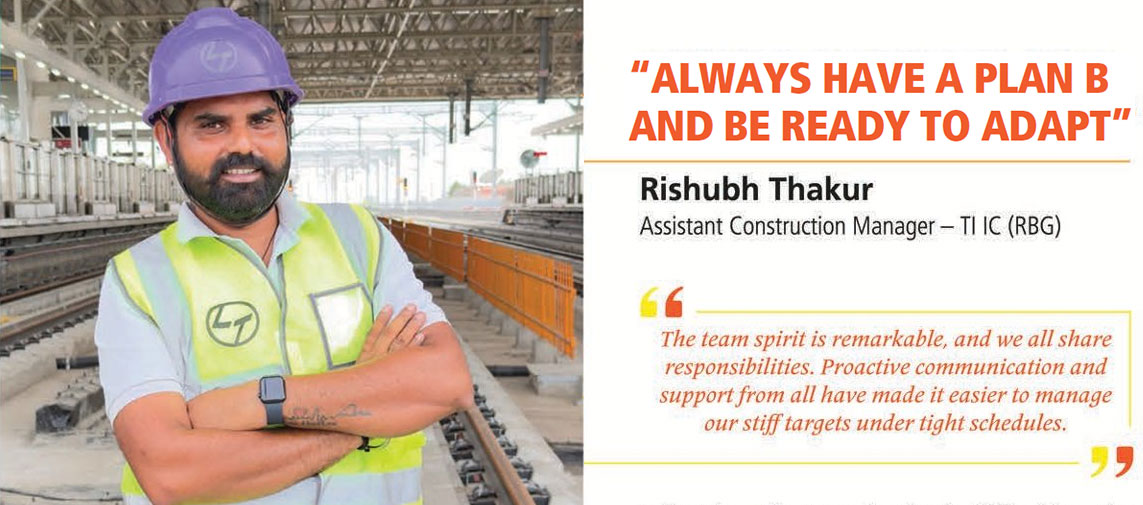
“Although my project responsibilities keep me thoroughly engaged all through the week, I try to dedicate my weekends for other activities,” smiles Rishubh Thakur. “I enjoy spending time with my dogs and have a strong passion for hiking.” Even as a construction professional, he believes that pre-planning and coordination between teams are critical. “One key lesson I have learnt is to always have a Plan B and be ever ready to adapt quickly when real-site conditions deviate from drawings,” he points out astutely.
Having earlier served as Senior Engineer on major infrastructure projects including the Delhi Metro Phase 4, MEGA (Metro-Link Express for Gandhinagar and Ahmedabad), and the Eastern Dedicated Freight Corridor (EDFC CP304), Rishubh’s first assignment with L&T was at the Hyderabad Metro Rail project. “Currently, I am leading the slab track turnout installation works on the RRTS Metro project,” he informs, “where we have implemented the RRV Hydra 360 for slab placement on viaducts to increase our speed of work.”
As they are installing slab track for the first time in India, the biggest challenge facing Rishubh and team was to adequately train unskilled labour in precision track installation. “We overcame it through daily toolbox talks, mock setups, and creating visual SOPs, while weather interruptions were handled by pre-scheduling buffer activities.” Their digital track alignment tools are also immensely helping the team by providing real-time feedback and accurate data during rail installation, which has significantly reduced manual checking time and increased laying accuracy.
As a young man still on a steep learning curve, Rishubh acknowledges the important role played by his seniors in his development, guiding him through technical reviews and planning sessions. “The team spirit is remarkable, and we all share responsibilities,” he shares with evident josh. “Proactive communication and support from all have made it easier to manage our stiff targets under tight schedules,” he grins.
Watching the first successful turnout installed on the viaduct with L&T’s FLS batch 2020 was a proud moment for Rishubh. “Being appreciated by my seniors and clients after the completion of the installation was a wonderful feeling too,” he says delightedly.
About his personal life, Rishubh shares that he comes from a close-knit family, with his parents residing in his hometown of Hararfatehpur, Shamli, Uttar Pradesh. “I am married to Anupama Chauhan, who is currently working from home for a US-based software company, and I must say that it is the unwavering support of my family that has been instrumental in shaping and sustaining my professional journey,” he says with his eyes shining.

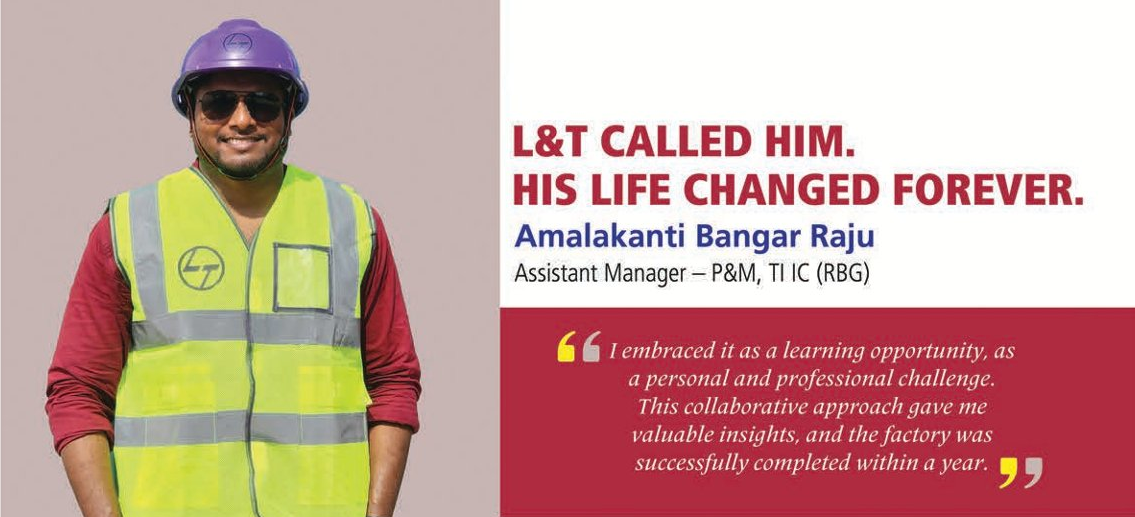
A moment that Amalakanti Bangar Raju will cherish all his life is when he received a call from the HR department informing him that he had been selected for a position in L&T. “That call gave me a career, a purpose, and more importantly, the ability to support my family,” he shares passionately.
Having joined as a DET in 2013, he began his tenure at the WDFC CTP project 1 & 2 managing P&M operations till 2020 after which he moved as one of the first team members from the P&M side to the RRTS track works project, where Raju’s first opportunity to make a mark was to set up a first of its kind in India factory, ground up. Не found the task particularly challenging as it required an entirely new set of skills and knowledge, different from his previous experience. “However, I embraced it as a learning opportunity, as a personal and professional challenge,” he says resolutely. He started to proactively engage with various OEMs and participate in several technical discussions and brainstorming sessions with senior OEM representatives to understand the machinery & layout requirements, and commissioning processes. “This collaborative approach gave me valuable insights, and the factory was successfully completed within a year,” he shares triumphantly, adding that the full support from the L&T management was a key contributory factor in his success.
Raju flags off their digital fuel management system to control diesel distribution and prevent fuel theft as another triumph that comprises a Computerized Dispenser Unit installed in diesel tankers to ensure fuel delivery, accurate up to 0.2%, and pre-configured RFID tags affixed to the diesel tanks to identify the receiving unit during fuel dispensation, eliminating manual errors or tampering. “The real-time data such as quantity dispensed, asset information, and GPS location is transmitted directly to a central server for seamless reconciliation and transparent monitoring of diesel usage across the site,” informs Raju. “Apart from significantly strengthening our fuel management practices, this system has improved accountability, minimized losses, and enhanced operational efficiency.”
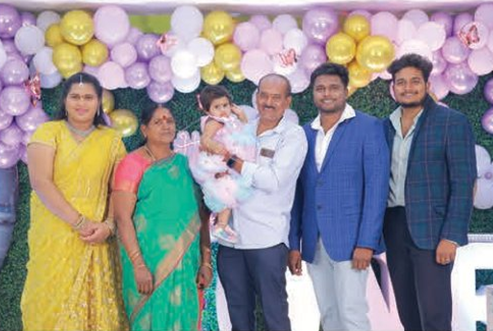
As part of the P&M team, Raju has learned that timely deployment and optimal utilization of equipment can significantly impact project timelines. “Early engagement with all stakeholders, including OEMs, execution teams, planning departments, and vendors is key to identify potential bottlenecks and streamline execution,” he points out, putting a premium on teamwork and collaboration too.
On his personal front, Raju, who hails from Visakhapatnam, Andhra Pradesh, is married to Enni Divya Deepti, a homemaker, and cherishes the time he spends with his two-year-old daughter, Amalakanti Hanvika. He unwinds by playing cricket on weekends and jogging while listening to music.

Although hailing from a farming background, since childhood, he dreamt and everyone in his family wanted Ankur Yadav to join the army to serve the country. Somewhere along the way, he changed tracks. But after 12 years in precast production, he does not regret his decision. “4 years with my dream company L&T has been great. There is so much respect I get when I mention that I work for L&T and I am delighted that even now I am serving the nation,” he says with great satisfaction.
Of his 8 years outside L&T, one of his assignments as Production Manager was at the Statue of Unity. The last 4 years since 2021, as Senior Precast Engineer, at the RRTS Track works project, Ankur has been overseeing the production of approximately 45,000 track slabs, 2,364 turnout slabs, managing steel cage prefabrication, supervising the early stages of the depot set-up, sleepers, ballast unloading and even handling the client.
To accelerate production, Ankur mentions the introduction of the SDS Scanning System, using RFID tags, and the FARO laser method to ensure zero-defect slabs with real-time quality checks that have slashed rejection rates and streamlined inventory. “By optimizing every stage of our production system, from concrete mixing to precast slab molding, through a fully automated concrete distribution setup, we have ensured seamless operations,” he explains. “Advanced surveying with the FARO method guarantees precision by aligning ‘As Manufactured’ slabs with their 3D models, eliminating human error.”
While the Quality App has digitalized RFI tracking, the SPOT system addresses deficiencies. Shortage of manpower has been addressed by motivating local vendors to complete the factory setup on time and organizing workers from CSTI into specialized teams, training them for each precast activity to ensure proficiency from day one. “This approach has significantly reduced errors, boosted quality and speed of production on a large scale,” enthuses Ankur. “By offering technical guidance and consistent support, we have empowered teams to complete tasks accurately and on schedule.” He also mentions their ‘innovation’ to cure the slabs from below in a hanging position right after demoulding to save time and speed up production and extending the handle of the spray pump by a meter to avoid the safety hazard of standing beneath the slab when curing.
Hailing from Pali, Haryana, Ankur is married to Nirmala Rani, a homemaker, and they have two sons, Shivank and Aadi Rao. His hobbies include swimming, kabaddi, and writing.
To sum up, Ankur advises, “To move fast you got to move slow. Invest in team learning, mentorship, long term quality; allow seniors to lead and mentor; do not fall into micromanagement because velocity comes from owner driven delivery, not forced deadlines.”
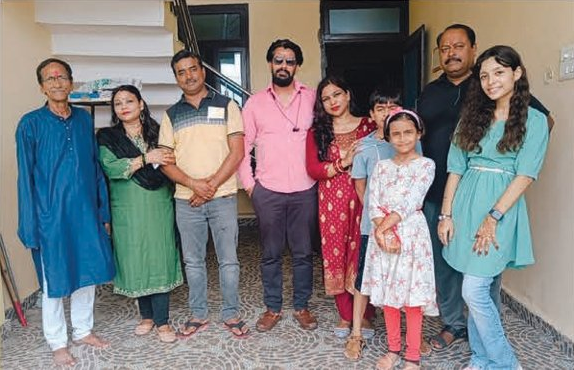
BEING PART OF SOMETHING BIGGER THAN ONESELF INSPIRES ME
Swarup Kumar Bhaumik
Survey In-charge, TI IC (RBG)
“L&T’s culture of trust, empowerment, and continuous learning motivates me to grow every day, take ownership, and contribute meaningfully,” states a charged Swarup Bhaumik, proud of the company he keeps. “It’s an organization where performance is recognized, innovation encouraged, and values never compromised. Being part of L&T means being part of something bigger than oneself that truly inspires me.” Honing his skills as a Survey In-charge, he has worked at the Hyderabad Metro project, thereafter at the Riyadh Metro project and is presently at the RRTS track works project where he has been confronted with several challenges being a large-scale infrastructure project but have successfully overcome them with strategic planning and proactive action.
“Our focus is on delivering zero-defect work with speed,” Swarup says confidently, “and by adopting FARO 3D laser scanning for precast track slab inspections, we have minimized rejections, reduced rework, and accelerated construction milestones with quality.” He shares excitedly that one of his most memorable moments professionally was receiving a letter of appreciation from the Executive Director NCRTC (Client) for developing and implementing the complete survey scheme including the laser-based FARO system & for installing the semi high-speed precast slab track.
Taking challenges in his stride, Swarup has tackled the issues of tight deadlines, design mismatches, and skill gaps by developing micro-level schedules, coordinating with agencies for swift design clarifications, and conducting skill development sessions to enhance workforce efficiency. “Proactive planning and disciplined execution are important for timely project delivery,” he notes, adding wisely that speed is not just about doing things fast but it’s about doing the right things with precision, foresight, and collaborative momentum. While strategic planning lays the foundation, true acceleration comes from anticipating challenges, deconstructing the scope into micro-level actionable tasks, and maintaining rigorous daily follow-up with clear accountability.

The clear direction, well-defined roadmaps and mentorship from his seniors have helped Swarup to prioritize critical tasks and anticipate challenges, while his team’s collaborative spirit ensures seamless cross functional coordination. He opines that integrating Al-powered predictive project management systems will further enhance real-time decision-making and site efficiency.
A native of Baikunthapur, Hooghly, West Bengal, Swarup is married to Sutapa, a homemaker, and a proud father to daughters, Swagata and Susmi. In his downtime, he enjoys reading newspapers, listening to old music, and taking nature walks to recharge. Signing off he proudly shares about the DELTA award he won in the Technological Advancements category and the appreciation he received from the senior leadership.
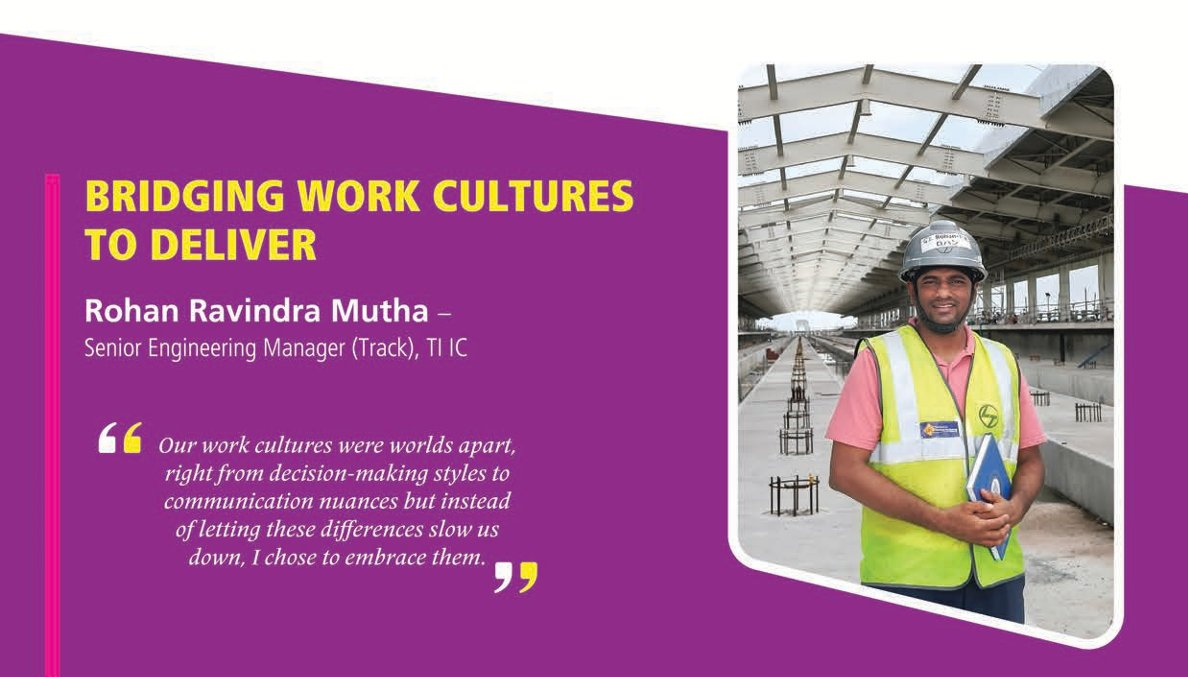
As a Design Manager, a digital solution that has truly warmed Rohan Mutha’s heart is the automation of the construction drawing preparation process at the MAHSR T3 project where he is responsible for track design and interface management. “We developed an integrated workflow that connected site-level survey data directly with Autodesk Civil 3D using Dynamo scripts that helped generate construction drawings with minimal manual input,” he shares with josh. “As a result, we significantly enhanced both accuracy by eliminating manual data entry errors and efficiency in drawing approvals.”
While working on such a prestigious project is enormously fulfilling, a stern test for Rohan has been working with the Japanese stakeholders that has been both a challenge and a learning curve for him. “Our work cultures were worlds apart, right from decision-making styles to communication nuances but instead of letting these differences slow us down, I chose to embrace them,” he says with maturity. “I listened more, adapted my approach, focusing on building genuine relationships grounded in trust and respect. Over time, those cultural gaps turned into bridges, and collaboration became our biggest strength,” he says with punched fist.
Turning his attention to site issues, Rohan mentions the significant delays in developing RC track bed drawings to resolve which the team implemented digitalization and automation of the drawing process that increased accuracy, efficiency and ‘first-time-right’ approvals. Another issue they encountered at the Anand Station was the proposal for a longer solid track bed, with synthetic sleepers continuing post the Rail Expansion Joints (REJs). “After a technical review, we repositioned the REJs to reduce the required length of the solid track bed and the number of synthetic sleepers needed,” he remarks. “This revised structural design was both technically sound and efficient.”
Drawing from his experience of having worked earlier at the Mumbai Monorail, Navi Mumbai & Pune Metro projects and now at MAHSR, Rohan believes that proactive interface and stakeholder management are critical for the success of large projects. “Early alignment across disciplines can mitigate delays significantly and with structured review processes, digital workflows, and real-time coordination mechanisms, we can ensure that execution fronts are continuously fed with approved drawings.”
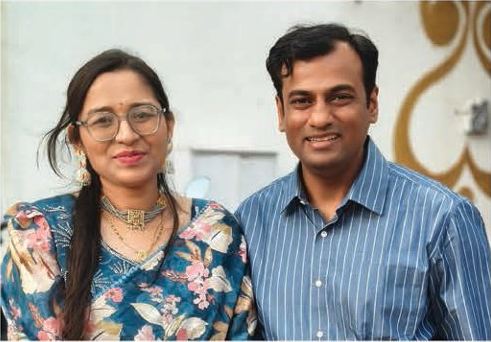
His seniors’ trust and timely guidance empower his decisions, while teammates’ proactive suggestions refine design processes. “Their collaboration drives our accuracy,” Rohan notes gratefully.
Hailing from Ahilyanagar, Maharashtra, Rohan is married to Swapnali Rohan Mutha, a civil engineer from his same academic batch, specialized in water supply design, and cherishes his time with their son, Viaan. “Family moments and Marathi theatre weekends recharge me,” he says warmly.
SPEED IS NEVER AT THE COST OF COORDINATION AND QUALITY
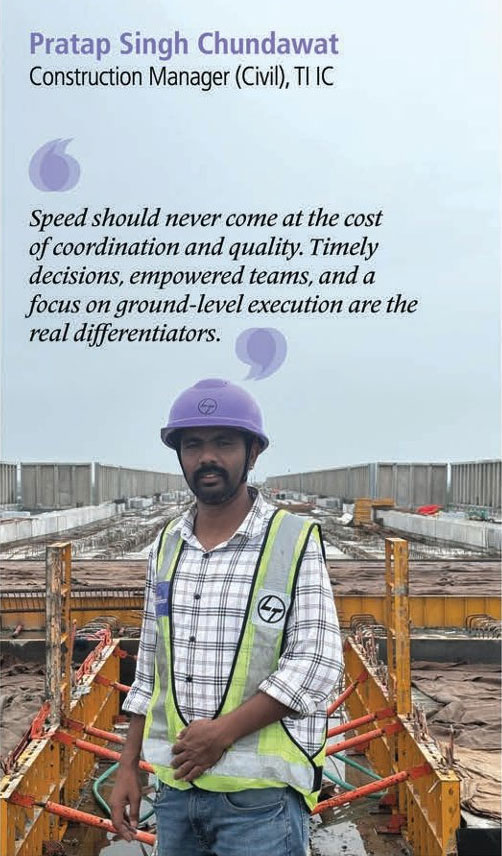
His 13 years with L&T, working on iconic projects like the Mumbai Monorail, WDFCC EMP‑4 and presently, MAHSR T‑3, have taught Pratap Chundawat that delivering large projects hinges on clarity of roles with every individual taking on responsibility and ownership of the task assigned. “Projects of scale demand that each activity is well thought out in terms of logistics, resources, safety, and interfacing,” he emphasizes. “Speed should never come at the cost of coordination and quality. Timely decisions, empowered teams, and a focus on ground-level execution are the real differentiators.” Happily, he experiences a lot of this in L&T’s culture of ownership, technical excellence, and value-driven execution, that continuously challenges him to grow and perform at his best.
At the MAHSR T‑3 project, Pratap’s focus has been to speed up progress of the RC track bed, mentioning drone surveillance of the alignment to detect deviations early for timely corrective measures and deployment of a special type of fabricated steel shutter as the construction involves repetitive casting of the same structure throughout the alignment that have significantly reduced delays and improved coordination across departments. “To arrange for tools and consumables, we monitor them digitally with tracking sheets and the Material NXT App to ensure material reaches the site team timely,” he nods.
Maintaining pace and quality when constructing the RC bed is critical especially during the monsoons for which the team has implemented modular planning with micro-level activity breakdowns for better monitoring & resource allocation and optimized deployment of equipment and manpower by doing shuttering and reinforcement binding during the day and RC track bed casting at night to utilize the TSMF factory batching plant. “Regular coordination meetings with interfacing teams have helped eliminate bottlenecks and reduce dependency delays while introducing a small tractor trolley has eased shifting shuttering material from one location to another,” remarks Pratap.
He attributes his success to the support of a proactive leadership team, who guide, and are always approachable for quick decision-making, and a motivated and skilled execution team who are entirely aligned with the project’s vision. Pratap is most impressed by their collaborative mindset.
Married to Anuradha Rathore, a devoted homemaker who anchors their home, that is brightened by his sons, Yograj and Vivan, whose births gave his life new purpose and direction. He plays cricket on weekends and downtime to unwind. “Those games with friends clear the clutter in my mind,” he smiles. “Professionally, one of my most memorable moments was the successful completion of the Marwar-Palanpur OHE section, a milestone that came with immense coordination and dedication,” he shares proudly.
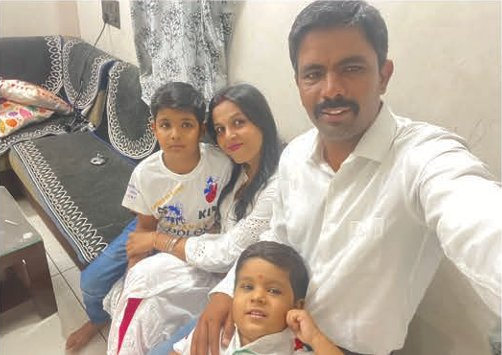
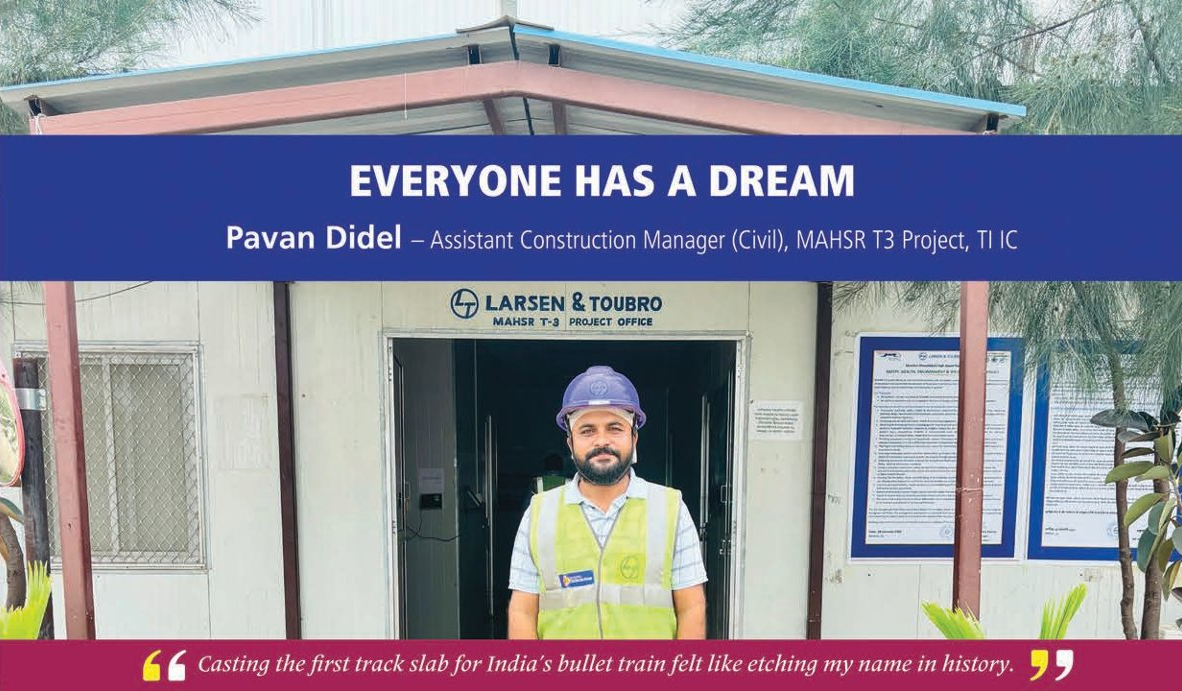
Casting the first track slab for India’s bullet train felt like etching my name in history,” Pavan Didel says, his eyes shining with pride.
Hailing from Harda, Madhya Pradesh, Pavan joined L&T in 2017 as a Graduate Engineer Trainee on the OPGC-MGR Project, where he managed bridge execution, including Open Web Girders and plate girders for NH and Mumbai-Howrah crossings, alongside rock slope protection and steel yard operations.
Since July 2022, as an Asst. Construction Manager on the MAHSR T3 Project, he has been involved in learning and adapting the J Slab technology for high-speed rail apart from being involved in building a precast facility in just eight months. “Seeing it run at peak capacity is a dream come true for the team,” he shares with a grin. Pavan was part of the team that brought in significant changes in track slab production with an automated steam control system, replacing manual monitoring with app- and web-based interfaces for precise curing. “This has slashed demoulding time and boosted efficiencу,” he says enthusiastically. To tackle stackyard congestion, they have expanded capacity and introduced a dual slab handling system using gantries‑a first in India’s high-speed rail history-ensuring uninterrupted production.
Challenges included optimizing the precast mould cycle; after three months of trials, Pavan and team succeeded in developing a concrete mix that could achieve M40 strength within 12 hours for M50-grade concrete that met a critical site requirement. Stackyard bottlenecks were resolved by enhancing infrastructure, streamlining operations and keeping the slab production pace relentless.
Continuous encouragement from seniors to innovate and his team’s collaborative feedback have been pivotal. “They empower us to push boundaries,” Pavan notes. “Vendors and subcontractors have brought technical expertise to life, and when everyone knows their tasks and has the right tools, coupled with the accountability and responsibility, we can accomplish tough tasks,” he says wisely. He foresees an automated slab finishing system to reduce manual effort and enhance quality.
Engaged to Komal Chaudhary, an HR executive in Pune, Pavan cherishes mornings spent reading, or playing cricket and badminton. He likes to travel too. “Every moment with my family feels special,” he says sincerely.
L&T’s legacy of excellence inspires him. “The freedom to experiment and grow, along with continuous learning & development, drives me to tackle challenges,” he smiles. “It’s a culture that fuels progress.” Pavan’s innovative spirit combined with his team’s dedication is shaping the MAHSR T3 Project into a landmark of speed and precision.

CRACKING THE SHINKANSEN CODE
Pasara Chanakya
Assistant Manager (ELEC) – P&M, TI IC
“Mastering the Shinkansen track machines was like learning a new dialect of engineering,” Chanakya says, his eyes sparkling with the thrill of discovery, who at the MAHSR Track Package, is overseeing track machinery maintenance and site electrical installations. The Shinkansen track machines, with their advanced automation and precision alignment, presented a steep learning curve for operators.
In response, Chanakya rolled out intensive operator training programmes and set up preventive maintenance schedules to bridge the gap. Limited availability of spare parts led to longer lead times for which local inventories were built, and indigenously manufactured equipment tested through OEM technology transfer to ensure reliability. Weather challenges, like heavy rain and dust affecting sensor accuracy, required recalibration; Chanakya’s meticulous scheduling minimized disruption.

loT-based machinery monitoring, digital progress tracking tools, preventive maintenance systems, and remote reporting solution across both projects have reduced downtime, improved resource utilization and accelerated task execution. “Real-time data keeps operations smooth and ensures we stay ahead,” he shares enthusiastically.
Another hurdle to overcome was Magnetic Particle Inspection (MPI) failures during rail welding, due to environmental factors like humidity and dust, and operator skill variations. To address it, the Weld Alignment Table was modified with fine-tuning mechanisms for vertical and horizontal alignment, clear calibration markings introduced, strict pre- and post-weld surface preparation standards enforced, and hands-on welder training focused on MPI-sensitive defects launched. “These changes slashed failure rates and kept progress on track,” he says proudly.

Seniors’ trust and clear direction enable rapid decisions, while teammates’ regular field updates and adaptability uphold quality. “Their coordination fuels our efficiency,” he says gratefully. Chanakya emphasizes proactive planning and stakeholder coordination for delivering large-scale projects with speed. “Training teams early cuts execution time,” he reflects thoughtfully. He foresees an Al- and loT-powered portable condition-monitoring system for real-time diagnostics of motors, circuits, and power distribution, to predict failures and automate billing via the Enterprise Information Portal.
Having begun his career journey with L&T as an Electrical Engineer on the WDFC CTP 1 &2, this native of Srikakulam, Andhra Pradesh, is married to Nandini, a homemaker who skilfully manages their home. Chanakya cherishes their three-year-old son, Neelaansh, whose birth was his most life-changing moment. He carves out time to explore construction technology and space news. “Those insights inspire my work,” he smiles. L&T’s reputation for excellence and innovation drives him. “Contributing to transformative infrastructure is a privilege,” he says with glowing eyes.
LEARNING THE ROPES QUICKLY
Krishna Kodavati — Manager (Track), TI IC
After an initial stint at the Navi Mumbai Metro Rail project as Track Senior Engineer, Krishna Kodavati is presently at the MAHSR T3 project as Site Manager learning to deal with the Japanese Shinkansen Bullet Train technology and create tracks for trains to zip around at 320 kmph. “A unique technology that we have implemented is the digital slab installation gauge to install the 4.9 m precast track slab on the main line,” he explains, “which has helped us achieve 0.1 mm accuracy levels.
Considering the project’s size and scope, it is understandable that Krishna has had to face his fair share of challenges like tight deadlines, coordination between multiple stakeholders, unexpected on-site issues, and of course, understanding the new Shinkansen J slab track technology to overcome which he has plotted his plan of action. “My steps have been effective planning and prioritisation to ensure critical tasks are addressed first, proactive communication with stakeholders to resolve issues before they escalate, regular progress monitoring to identify and address delays early and adopting a flexible problem-solving approach,” he shares. “In fact, one of my most memorable moments was achieving a major project milestone of completing 49 FBW joints in 11 hours with 100% quality after months of hard work and coordination,” he shares excitedly.
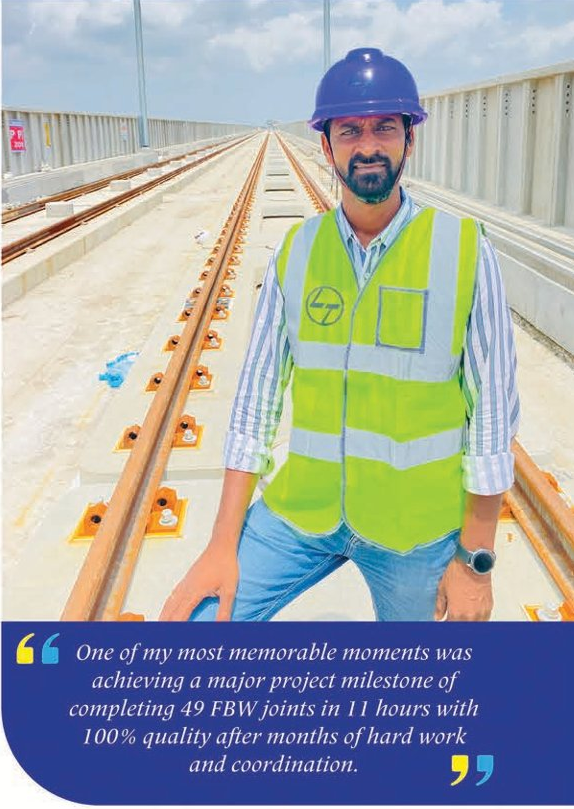
Drawing from his experience thus far, Krishna believes that clear planning combined with seamless coordination among all stakeholders and the execution team are the key factors of successfully delivering large projects. “It is always better to address issues proactively rather than reactively to significantly save time,” he notes. “Early identification of risks, open communication, and timely decision-making ensure that projects stay on track without compromising quality.”
Although his project has deployed several tech solutions at site, one new technology he would like to have is an integrated real-time project monitoring system that can track progress, resource usage, and detect potential delays live from the site.

“One aspect of L&T that stands out for many people is L&T’s legacy of delivering nation-building projects with uncompromising quality and engineering excellence and that culture of innovation, resilience and impact is what makes us proud L&T‑ites.” By sharing their experience, guiding him to prioritize tasks, and encouraging him to smart, efficient ways of working, Krishna’s seniors and team members have helped him grow by creating an open environment where doubts can be clarified, best practices learnt.
Hailing from Kakinada, East Godavari in Andhra Pradesh, Krishna’s life partner is Bala Tripura Sundari, a homemaker, and the love of their lives is their daughter, Saanvika. He loves to play cricket, especially over the weekends.